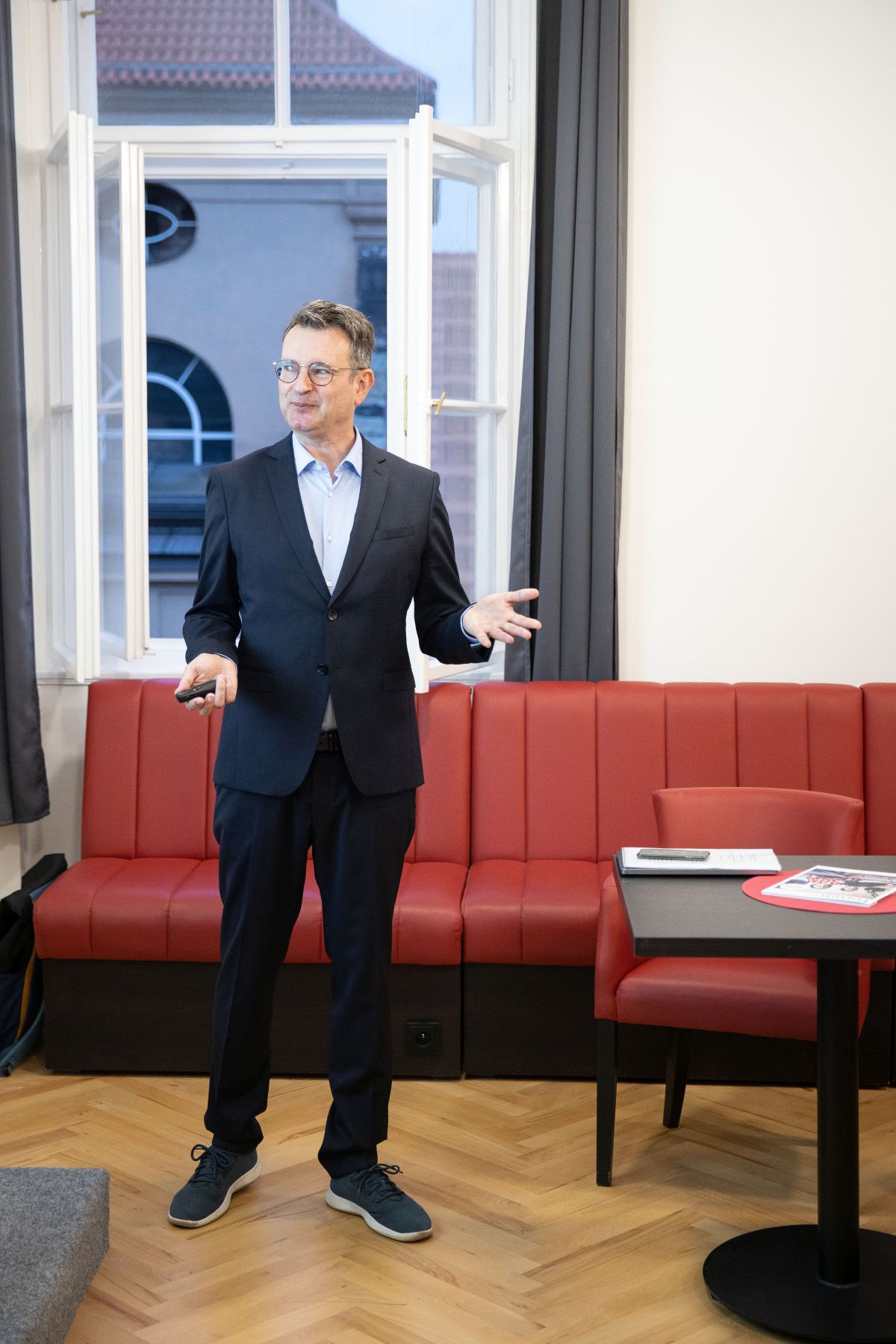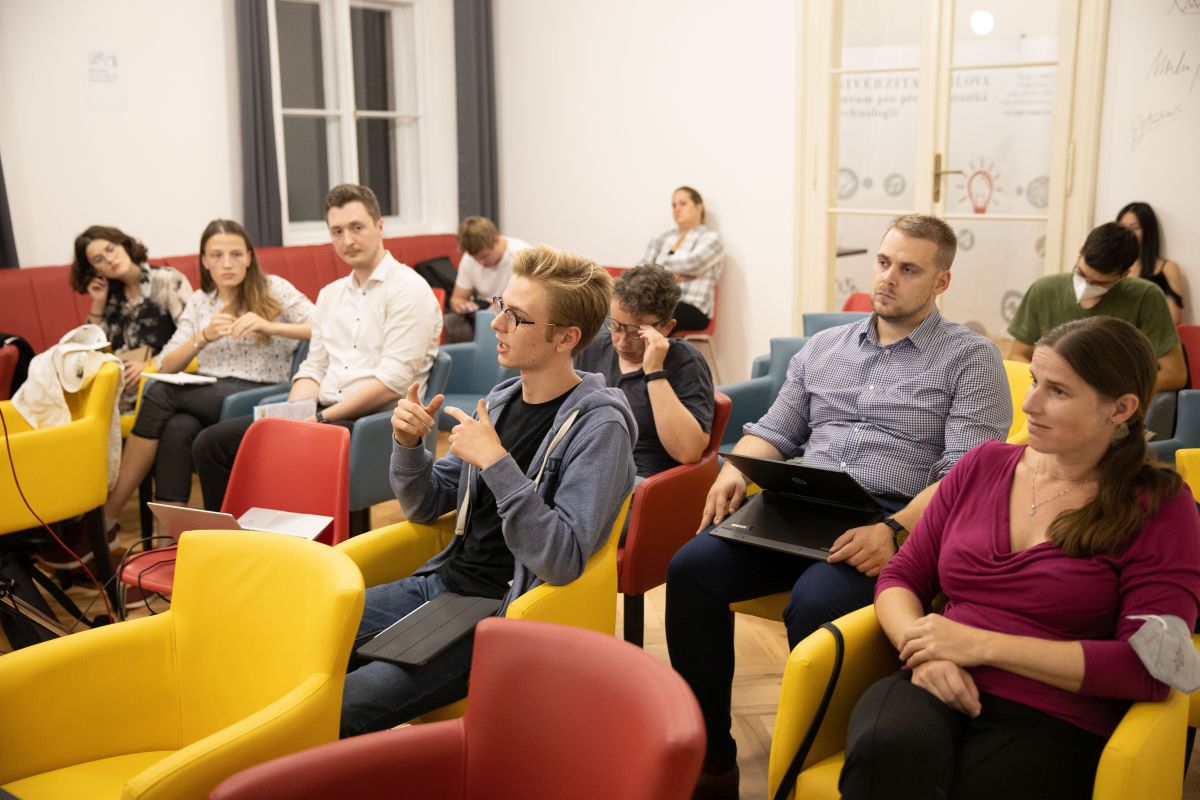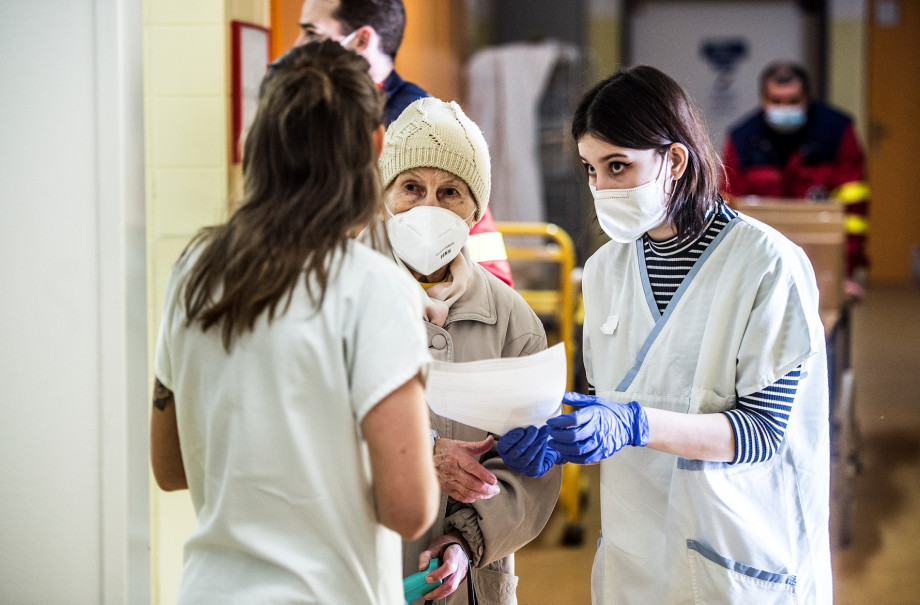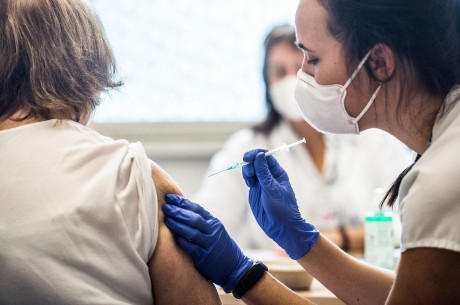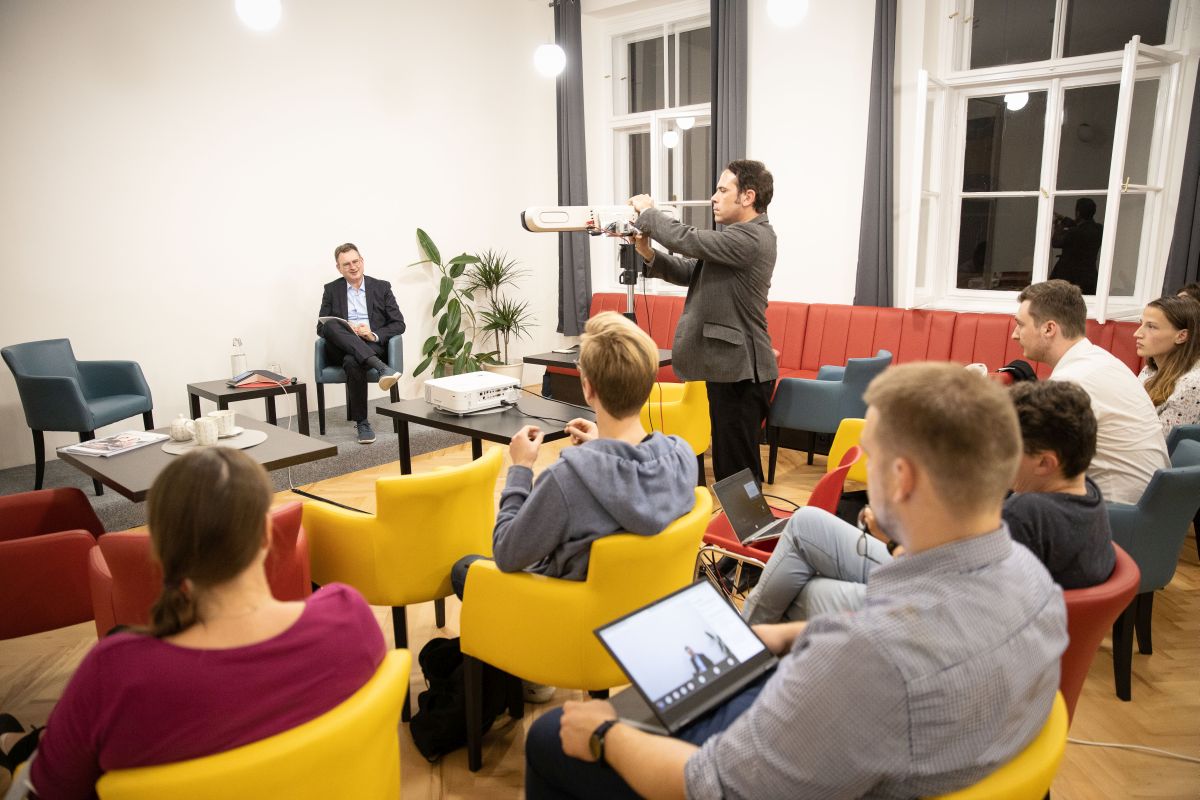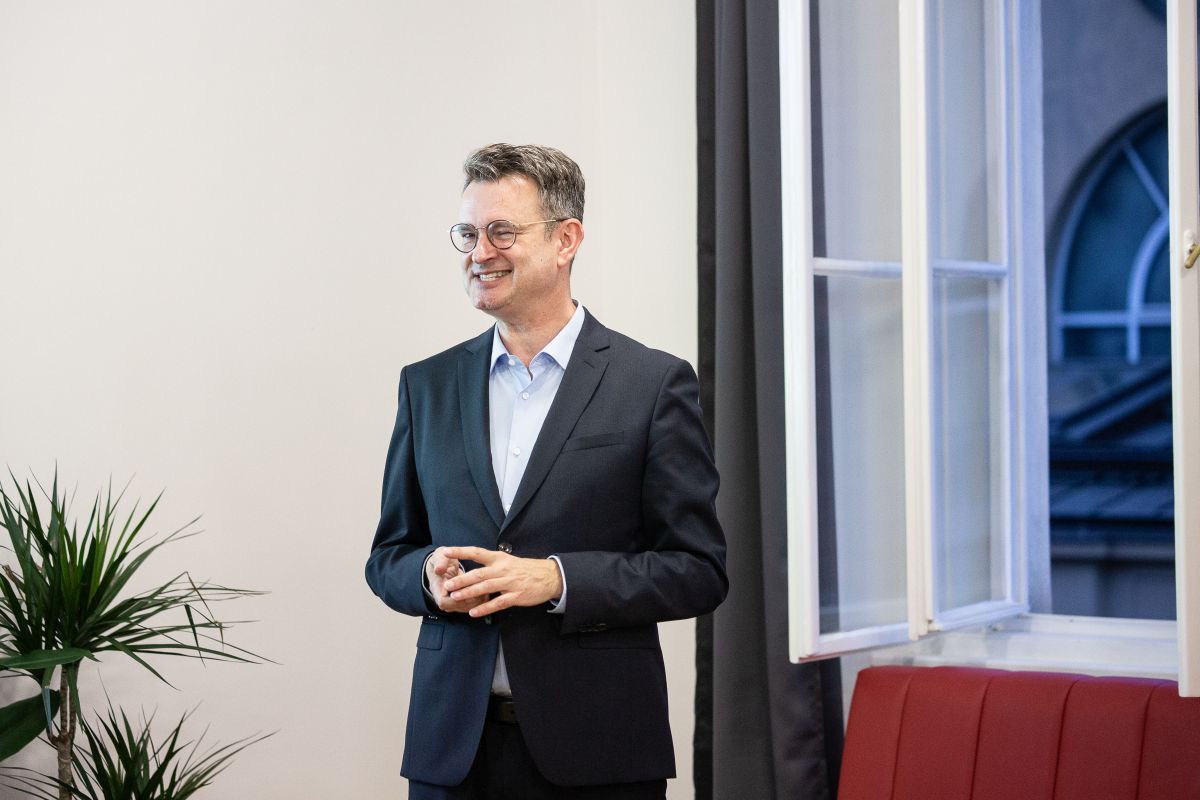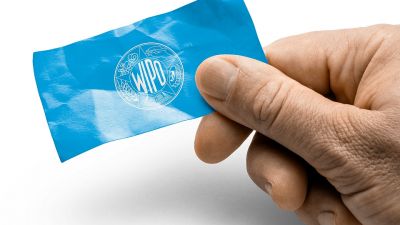With vaccines widely available in Europe, it is easy to forget, even just a year-and-a-half later, the urgency with which they were developed. A moon shot that proved successful. Duncan Matthews, an expert on IP and IP law at Queen Mary University of London, makes clear that despite the success, there are aspects that could have been handled better. In a lecture at the WIPO Summer School at Charles University co-organised by the Centre for Knowledge and Technology Transfer (CPPT), he focused on the Oxford-AstraZeneca vaccine: what we know about the IP and where we remain in the dark.
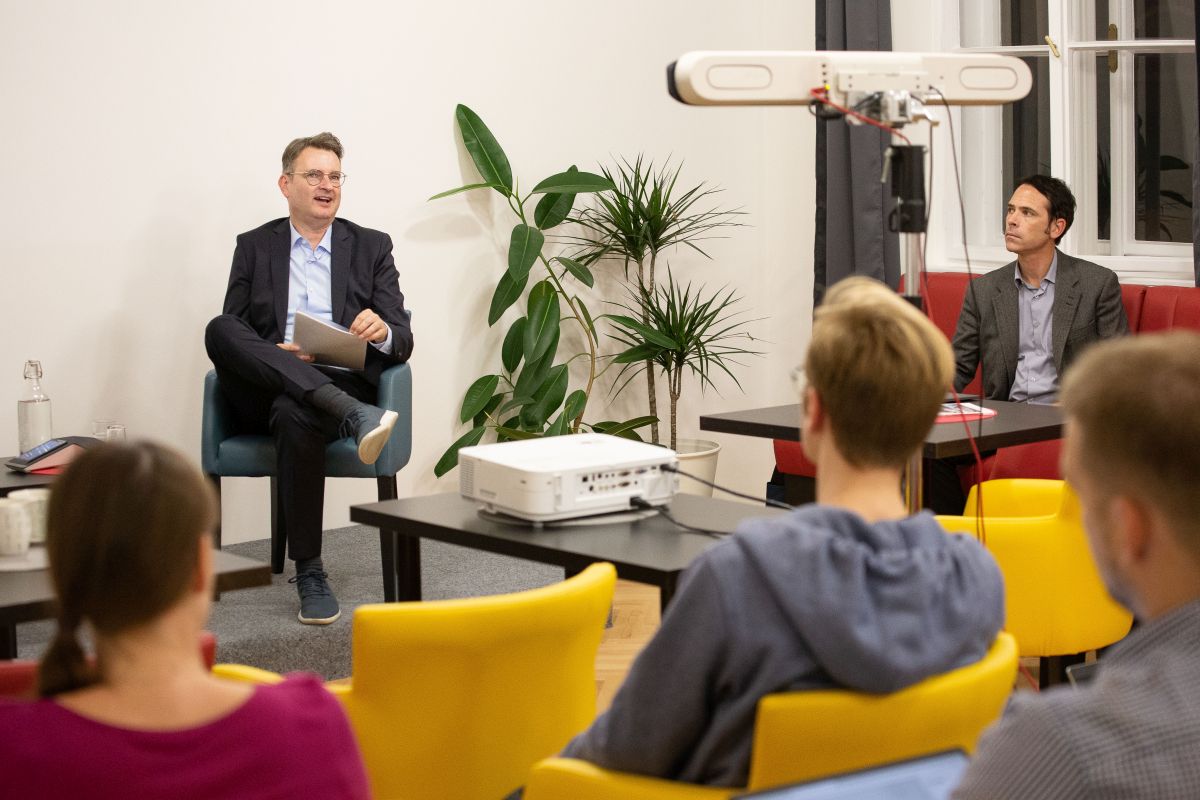
Professor Duncan Matthews (left) giving a presentation on IP and the Covid-19 vaccines at WIPO Summer School at CU on September 15, 2021.
Professor Matthews told me more when we met at Charles University.
My research focuses on patents and intellectual property related to vaccines and one of the things that I wanted to show in my lecture at Kampus Hybernská was just how much information is already in the public domain. If you go looking for it, you can look up patent applications, medicines that have been approved, any side-effects, and the batch number of the vaccine you were given. In July of last year, the scientists who invented the Oxford-AstraZeneca vaccine first published their results in Nature and declared related patents at the end of the article. This led me to try and find out more.
You mentioned that the scientists at Oxford had had an advantage: intellectual property filed many years earlier, related to similar research…
The research that eventually led to the Oxford vaccine was overwhelmingly from public funding, originating in 2012 at the time of the MERS outbreak, the Middle East Respiratory Syndrome coronavirus outbreak. It was really a case, during the Covid-19 pandemic, of retooling and repurposing that research which had already been ongoing. That is the reason why the Oxford scientists were able to act so quickly. The funding was from the UK government, from a German federal government research centre (the German Centre for Infection Research or DZIF) and the Oslo-based Coalition for Epidemic Preparedness Innovations (CEPI), funded, for example, by the Bill and Melinda Gates Foundation which is an international charity.
The question faced by the scientists (having invented this vaccine for the benefit of humanity) was whether it should it be free for everyone or controlled somehow by the private sector and the international patent system. After the patent applications had been filed, that led to many questions about what the best model for making the vaccine available would be: do you allow a free-for-all for everyone or do you try and manage availability through licensing agreements?
I think that this is where universities in general, and Oxford University in particular, can and did provide a good model of private/public partnership. The university was in a strong position as the owners of the IP and, with the input from the UK government’s Dept. for Business, Energy & Industrial Strategy, the decision was taken to give an exclusive license to AstraZeneca to manufacture the vaccine and distribute it worldwide. In return, the company agreed that, as long as the World Health Organization (WHO) designated Covid-19 as a global pandemic, no profit would be made by AstraZeneca or Oxford University.
Of course, now we are in a situation where people are starting to talk about ongoing booster shots with the outlook being that Covid could become like the winter flu with vulnerable people requiring shots every year. We do expect that AstraZeneca will make substantial profits and even Oxford University will earn something like fifty million pounds in booster shots after the pandemic phase ends. So, this is where the controversy arose: do we give the exclusive rights to the manufacturer, do we allow anyone to use it, what happens during the pandemic, and should the situation change once it is over? These were all interrelated and complex questions.
You discussed an example of one of the license agreements (between AstraZeneca and Brazil) where details were leaked. Curiously, the contract defined ahead of time when the pandemic would be over. Which given the pandemic is still ongoing, seems somewhat arbitrary.
In the contract AstraZeneca defined that the pandemic would be over in July 2021, but of course it isn’t. It allows the firm, if it wishes, to impose the contractual clause in Brazil and they could say “Now we are entitled to make a profit.” The answer to your question is again whether we want publicly-funded research at universities by academics to become privatised in a way that both the contractual agreements (known as advance purchase agreements with national governments or the EU) remain confidential or secret.
Attempts by academics such as myself to see what is written in these contracts have not been successful. Even when information was released, all commercially sensitive information, including the price, was redacted as were details about what would happen with the IP and so on. And that has led to significant debate. Because we don’t know whether the vaccine manufacturers are playing by conventional business rules. Since AstraZeneca, but also some of the other vaccines, began with publicly-funded research, should [the actors involved] behave as if this was a private investment?
There is also a question about liability: in the UK deal, the traditional agreement was switched. Normally, the pharmaceutical manufacturer would be liable for any adverse effects – injuries or deaths. But I discovered, through a [side route] that was the government’s budgetary review – that the government that had set aside funds if there were claims from families for anyone that had died as a result of taking the vaccine. It wouldn’t be the company that would have to pay for that. That seems to be an unusual situation. It is as if the risk, the risk of the research and of possible adverse effects and the compensation, was being absorbed by the public sector, while the rewards appeared skewed towards the manufacturer. So I think there are legitimate questions that need to be asked: who bears the risk and who gains from the profit?
Would you say that there was room for this kind of “unusual” manoeuvring precisely because of the unprecedented urgency and speed of the pandemic?
I believe that is correct. The urgency of the pandemic resulted in vaccine nationalism that saw governments race to be the first to sign contracts with vaccine manufacturers. Certainly there are examples of this in the United Kingdom, in comparison to the European Union. The European Commission faced criticism for being slower in signing vaccine contracts and the UK was quicker in developing the vaccine and took more risks in signing advance purchase agreements and the country’s vaccine taskforce behaved something like venture capitalists in this respect.
The EU treated the vaccine contracts as a standard public procurement exercise and as a result the UK got the vaccines faster but that doesn’t mean in the long-term that they got the better deal. Until there is a successful freedom of information request where we get to see those complete contracts and compare them, [what we say is] merely conjecture based on a minimal amount of information that is publicly available.
It is worth remembering that early on it was not clear that any of the vaccines would actually work. Nothing like this had ever been attempted and as a regular citizen, I remember the relief that many had succeeded where they could easily have failed.
It’s certainly the case that the speed was akin to landing a human being on the Moon the same year that politicians proposed it. Less than 12 months. The inequalities of the system shouldn’t detract from the huge scientific achievement that saw individual Covid vaccines brought to market so quickly.
Media outlets reported that successful vaccine manufacturing created nine new Pharma billionaires. That is exactly the kind of story that is grist for the mill for part of the public that distrusts pharmaceutical companies already and are vocal about it online.
The thing to remember is that typically in the Life Science sector is that the rewards are high for successful drug products because very high failure rates are common. It is compensation for the risk in bringing products to market. That was also true during the pandemic. AstraZeneca, Pfizer, Moderna began manufacturing their vaccines, even before they had received final approval from the world’s medicine agencies. It was entirely possible that, by the end of the process, these vaccines would have to be thrown in the trash. Either because they didn’t pass approval (because of serious side effects) or because they were not efficient in shielding people from the virus.
So even if it was publicly-funded research, the private sector assumed the risk by going ahead with manufacturing even before regulatory approval. And the risk was there. We saw just this week that the UK cancelled a contract with Valneva because it was doubtful the vaccine would get through the medicine approval process. The private sector assumes the manufacturing risk, so that is why we would expect to see high rewards for success.
That said, it is perhaps surprising that it is only AstraZeneca that is being sold at cost during the pandemic, even though the BioNTech technology was funded by the German government, through taxpayers, and the Moderna vaccine was originally funded by the US Department of Defense. All three were publicly-funded and the question to be asked is why these other companies are behaving differently from AstraZeneca. While AstraZeneca is selling it to the EU at two euros a jab, Pfizer/BioNTech and Moderna are selling for between 10 and 12 euros a shot. There is a big price differential for what is essentially the same result. One substantive difference is that the latter two are mRNA vaccines and therefore previously untried technology. So perhaps they would argue that this was an additional risk factor for them.
Even in countries where vaccines are readily available targets were missed (with the exception of countries like Denmark). Part of that is vaccine hesitancy related to distrust in either governments or the pharmaceutical industry. There is scepticism about among vocal segments of the population, who see the pandemic - and by extension boosters - as a “manufactured” crisis and cash cow. With such a wide deficit in confidence in our political elites over the last decade, how do you regain trust?
The key message, I would say, is that there needs to be greater openness and transparency at all stages of the vaccine development: research, production and supply. There needs to be greater openness about who owns the IP, what kinds of licensing agreements were signed with private companies, what those contracts stipulate, and what is written in advance purchase agreements, such as who is liable in the case of injury or death. And there also needs to be even greater openness at the clinical trials process and adverse effects among volunteers.
Because pharmaceutical companies traditionally treat all these issues as confidential, commercial information, there was insufficient openness with the public that exacerbated and compounded the lack of trust: in government, in vaccine manufacturers and ultimately in the safety of the vaccines themselves. It’s a key lesson: we need to look at what was done well and what could be done better in the future. Particularly because these vaccines were developed with public funds, it would only help governments as well as manufacturers to be more transparent about what was done for the public good.
| Professor Duncan Matthews |
| Duncan Matthews is Director of the Queen Mary Intellectual Property Research Institute at Queen Mary University of London. He has acted as an advisor to the European Patent Office (EPO), the European Commission, the European Parliament, the UK Intellectual Property Office (IPO), the World Intellectual Property Organization (WIPO) and the World Health Organization (WHO). He is the author of over 60 publications on intellectual property law, and he is co-editor of the Research Handbook on Intellectual Property and the Life Sciences. |
